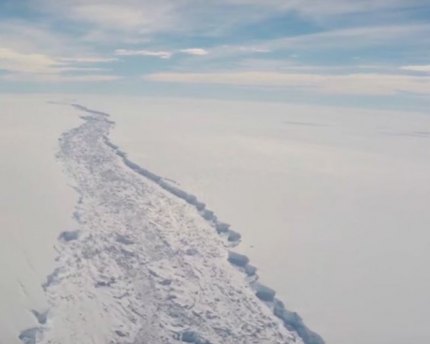Huge iceberg breaks free from ice shelf

This image shows the rift before the iceberg broke off.
Image: British Antarctic Survey.
The 5,800-square kilometer section (2,239 square miles) of Larsen C broke free at some point over the last three days. The volume of the iceberg is twice that of Lake Erie, according to scientists writing an account of events on the website for MIDAS, a U.K.-based Antarctic research project. They describe the iceberg as one of the largest ever recorded -- a trillion tons.
The iceberg was “already floating before it calved away so has no immediate impact on sea level. The calving of this iceberg leaves the Larsen C Ice Shelf reduced in area by more than 12 percent, and the landscape of the Antarctic Peninsula changed forever,” wrote two researchers, Adrian Luckman of Swansea University, lead investigator of the MIDAS project, and Martin O’Leary, a Swansea University glaciologist and member of the MIDAS project team.
Even so, there could be some impact on sea level change, they explain. If the remaining ice shelf loses much more area, “it could result in glaciers that flow off the land behind speeding up their passage toward the ocean. This non-floating ice would have an eventual impact on sea levels, but only at a very modest rate.”
Another branch of the ice shelf – Larsen B – disintegrated in 2002. And since 1995, the ice shelf has lost more than 75 percent of its former area, according to the National Snow and Ice Data Center’s website. Researchers had been monitoring Larsen C for years and had expected the iceberg to break off for some time. They watched the ice shelf using images from a European Space Agency satellite. At one point, the width of the rift was expanding by a meter per day.
On the website, O’Leary commented, “Although this is a natural event, and we’re not aware of any link to human-induced climate change, this puts the ice shelf in a very vulnerable position. This is the furthest back that the ice front has been in recorded history. We’re going to be watching very carefully for signs that the rest of the shelf is becoming unstable.”
Luckman wrote that the remaining ice shelf “could either gradually regrow, or may suffer further calving events which may eventually lead to collapse – opinions in the scientific community are divided. Our models say it will be less stable, but any future collapse remains years or decades away.”
Related:
Second rift in ice shelf worries scientists
Follow StudyHall.Rocks on Twitter.
If you would like to comment, give us a shout, or like us on Facebook and tell us what you think.

